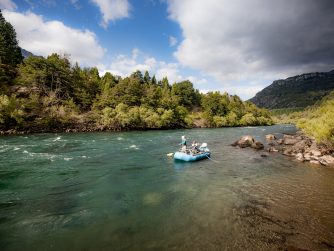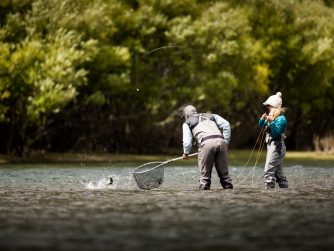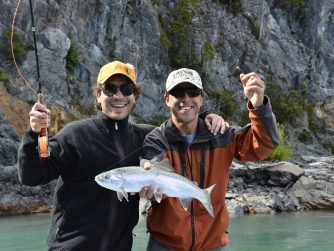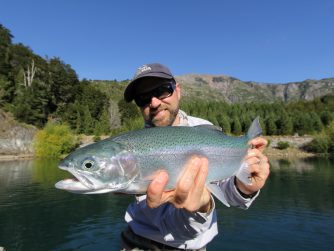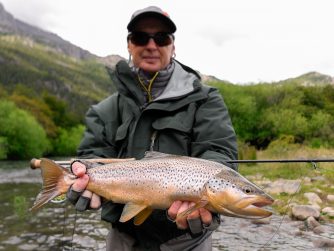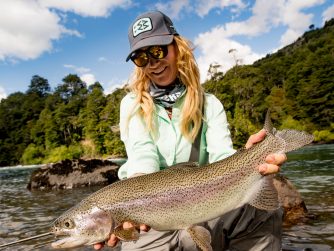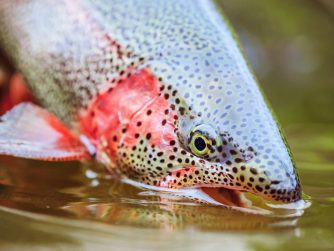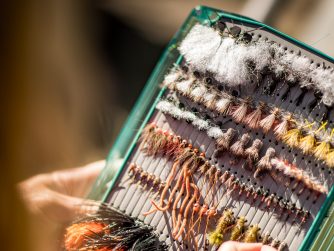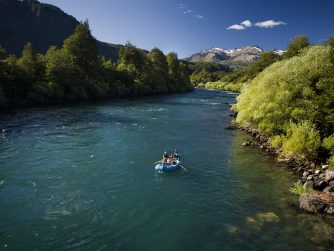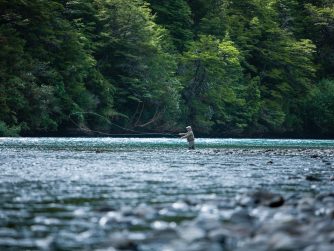Fly Fishing in Patagonia
The high-gradient, trout-rich Futaleufú River flows right by the front door of the lodge. Browns and rainbows are wild and healthy and can range up to five or more pounds. Fish eat a mix of streamers, dries, and nymphs, depending on the season, and terrestrial fishing is a summertime mainstay. Big fish on ultra-buoyant foam flies is our specialty. In addition to rafting the Futaleufú, we offer exploratory missions to remote streams and trophy lakes in the area.
Fishing Methods
To avoid the midday heat, anglers generally leave the lodge early in the morning, around 8 a.m. Guests return to the lodge for lunch and drinks around noon. After lunch and a siesta, boats will typically leave the put-in around 4:30 p.m., returning at dusk. Fishing hours will change slightly depending on the time of year. Anglers can also choose to fish through the entire day. (Be sure to make arrangements with the head guide well in advance.) Non-fishing activities such as horseback riding or canoeing are also available.
THE DAILY PROGRAM
Fishing schedules vary seasonally. However, a hearty breakfast is usually served around 7 a.m., while lunch takes place on the shore or back at the lodge depending on your daily itinerary.
FLY-FISHING EQUIPMENT
-
- Rods: Pack 9-foot, 5- and 6-weight rods. Fish dries on the 5-, and use the 6-wt for larger streamers or when dealing with stronger winds. Always pack a backup. Sage has a great lifetime warranty and offers several rod options perfectly suited for this fishery, such the Method and X.
- Reels: The average size of fish on the Futaleufú River is about 15 to 20 inches long; however, there are larger fish present! We recommend reels with capable drag systems and at least 100 yards of backing.
- Lines: Weight-forward floating fly lines are the norm on this river. Whatever you fish in Montana or the Rockies will also work great here. Also, bring an integrated sinking line (or two) for streamers. These lines should have anywhere from 10 to 20 feet of 200- to 300-grain sinking tips. For the lakes, use full-sinking and clear intermediate lines for streamers in deeper water. And always include a floater for dries.
- Leaders: Trout aren’t particularly leader-shy here. However, during the peak of the summer, especially in low-water conditions, these trout can become wary of heavier diameters. Bring 9- to 12-foot leaders in 3X to 5X for fishing dry flies. Go shorter and heavier (2X to 0X fluoro) for streamer rigs.
- Flies: The lodge has a good selection of local patterns, both for the Futaleufú and its tributaries, available for purchase. However, fly patterns will sell out. With that in mind, pack flies that you’d fish for trout on the spring creeks and freestone rivers of the Western U.S. or larger chalk streams of the U.K. Futaleufú trout are mostly opportunistic feeders. Therefore, attractor patterns typically get them looking up.
- Wet files: Woolly buggers (conehead or bead-head variety), rabbit-strip leech patterns (varying colors; generally darker patterns), sculpins, and Dog Nobblers (varying sizes in varying colors). Nymphs: Bring stonefly nymphs, dragonfly nymphs, damselfly nymphs, bitch creek, and other Pat’s rubber-legged-style nymphs. All bead-head style nymphs down to around size 18 and as large as size 6. Finally, bring a good selection of caddis pupa imitations between sizes 14-18.
- Dry Flies: Foam and parachute hoppers in sizes 6-12. Parachute Adams in sizes 12-18. Elk-hair caddis varieties in sizes 14-16. Humpys and Stimulators in sizes 10-18. Parachute and foam ants in sizes 16-18. General foam-bodied terrestrial patterns in sizes 8-16. Spent-mayfly patterns in sizes 12-18.
- Waders: Wading isn’t difficult on the Futaleufú, and you will be spending most of the time in a boat. However, we recommend chest waders for warmth and to manage deeper water when you need to. Wading boots can’t have studs, and felt is also forbidden. Vibram, or any sticky rubber-soled boot is the best. Given Chilean Patagonia’s climate, and water that can be in the 40s, be sure to pack long johns, wool or fleece pants, and wool or warm synthetic socks. Be sure to use a wading belt. We strongly recommend waders, layering pieces, and outerwear by SIMMS.

